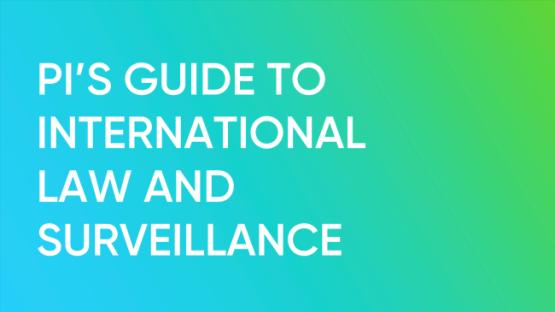
PI’s Guide to International Law and Surveillance
PI’s Guide to International Law and Surveillance aims to provide the most hard-hitting results that reinforce and strengthen the core principles and standards of international law on surveillance. You can find UN resolutions, independent expert reports and international human rights bodies jurisprudence.

First published in 2017, “PI’s Guide to International Law and Surveillance” is an attempt to collate relevant excerpts from these judgments and reports into a single principled guide that will be regularly updated. This is the third edition of the Guide. It has been updated it to reflect the most relevant legal developments until December 2021.
Despite its name, the Guide isn’t just aimed at lawyers. It aspires to be a handy reference tool for anyone engaging in campaigning, advocacy, and scholarly research, on these issues.
The third edition has been updated to reflect the most relevant legal developments since then. This includes:
- New resolutions adopted by the UN General Assembly and the UN Human Rights Council;
- Extracts from the most recent reports of different UN bodies; as well as
- Extracts from the most recent judgments of the European Court of Human Rights.
It also features new sections dedicated on “acquiring and selling surveillance equipment”, “biometric data collection”, and “protest surveillance”.
The Guide is quite long. Here are a few useful tips to make its use easier:
- It is not meant to be read it cover to cover;
- We suggest that you either use the table of contents or search for key words to find the most relevant quotes for you;
- The quotes in each section appear in accordance with their source in chronological order, starting from the UN sources (i.e., resolutions, reports, concluding observations, individual complaints) and then looking into regional human rights systems;
- Certain quotes have been shortened to focus on the essence of the standards they provide. On occasion, it may be useful to go back to the original source;
- Boxes across the guide highlight the most substantive articulation of the human rights standards applicable to the sub-issues covered under the relevant section. If you cite nothing else, these are the quotes that you want to reference;
- Only final judgments of the European Court of Human Rights are included.
The Guide is a living and breathing document and we will be adding new content as more statements and resolutions emerge. Please reach out to us via Twitter (@Privacyint) or email (info@privacyinternational.org) if you think there any additional references we should add, or topics you want us to cover.



